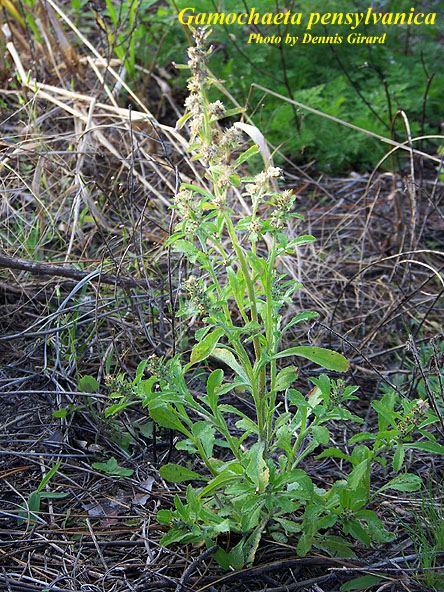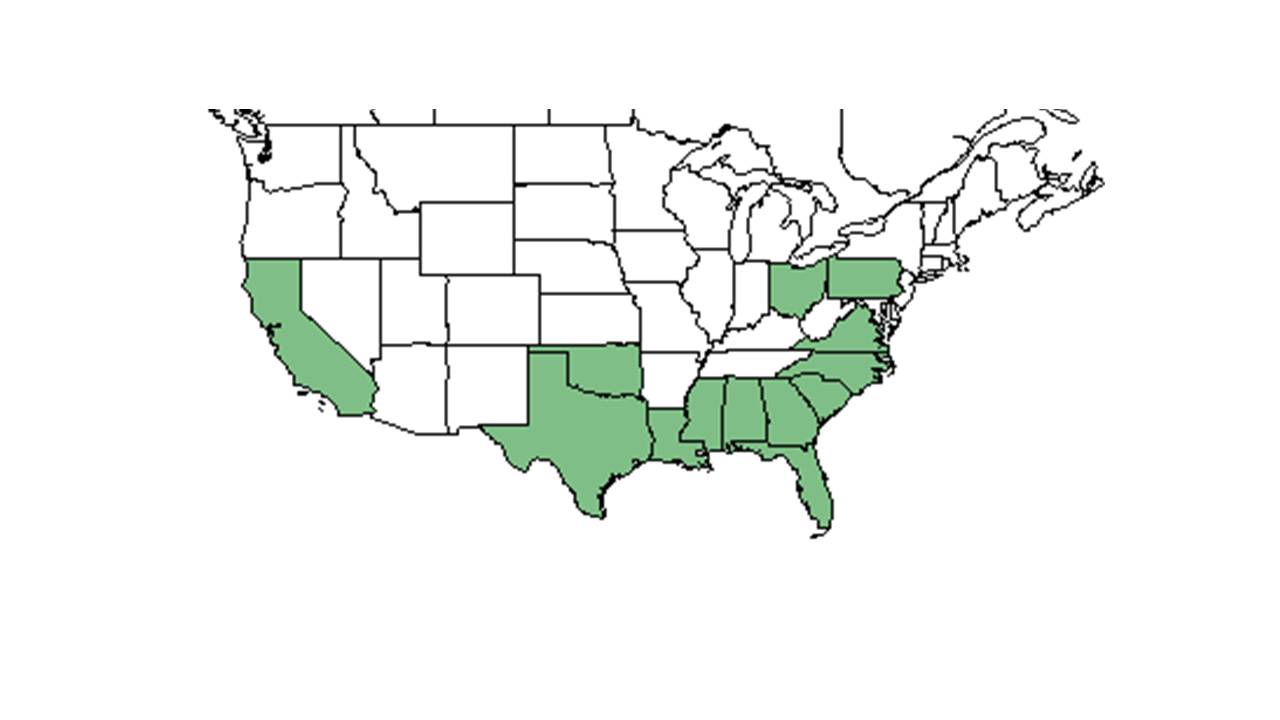Gamochaeta pensylvanica
| Gamochaeta pensylvanica | |
|---|---|

| |
| Photo by Dennis Girard, Atlas of Florida Vascular Plants | |
| Scientific classification | |
| Kingdom: | Plantae |
| Division: | Magnoliophyta - Flowering plants |
| Class: | Magnoliopsida – Dicotyledons |
| Order: | Asterales |
| Family: | Asteraceae ⁄ Compositae |
| Genus: | Gamochaeta |
| Species: | G. pensylvanica |
| Binomial name | |
| Gamochaeta pensylvanica (Willd.) Cabrera | |

| |
| Natural range of Gamochaeta pensylvanica from USDA NRCS Plants Database. | |
Common name: Pennsylvania everlasting
Contents
Taxonomic notes
Synonyms: G. peregrinum Fernald; Gnaphalium purpureum Linnaeus; G. purpureum Linnaeus var. purpureum; G. purpureum Linnaeus var. spathulatum (Lamarck) Baker; G. spathulatum Lamarck.[1]
Varieties: none.[1]
Description
A description of Gamochaeta pensylvanica is provided in The Flora of North America.
Distribution
This plant is a native of South America. In North America, it's found east in Pennsylvania, south to Florida, and west to Texas. It occurs mainly on the Coastal Plain.[1]
Ecology
Habitat
G. pensylvanica has been found in sandy loam of floodplain forests; scrubby growth of old burn in coastal hammocks; marsh edges; lake shores; fallow fields; dried up lake bottoms; cabbage palm hammocks; limestone glades; and pinewoods. It can be found in human disturbed areas such as roadsides, citrus groves, vacant lots, pastures, lawns, and fire breaks. Soil types include sandy loam, loamy sand, gray-black sand, and peaty soils.[2] Associated species include Acer, Celtis, Morus, Platanus, Populus, Quercus, Ulmus, Gamochaeta antillana, Hypochaeris glabra, Carex, Panicum commutatum, Stachys floridana and Gamochaeta coarctata.[2]
Phenology
G. pensylvanica has been observed to flower January through May and November with peak inflorescence in April.[3][2]
Conservation, cultivation, and restoration
Cultural use
Photo Gallery
References and notes
- ↑ 1.0 1.1 1.2 Weakley, A.S. 2015. Flora of the southern and mid-atlantic states. Working Draft of 21 May 2015. University of North Carolina at Chapel Hill, Chapel Hill, North Carolina.
- ↑ 2.0 2.1 2.2 Florida State University Robert K. Godfrey Herbarium database. URL: http://herbarium.bio.fsu.edu. Last accessed: Collectors: States and Counties: Compiled by Tall Timbers Research Station and Land Conservancy. Florida State University Robert K. Godfrey Herbarium database. URL: http://herbarium.bio.fsu.edu. Last accessed: October 2015. Collectors: Loran C. Anderson, Wilson Baker, C.W. Campbell, Andre F. Clewell, H.S. Conrad, George R. Cooley, Richard J. Eaton, A. Gholson Jr., R.K. Godfrey, Ann F. Johnson, R. Komarek, Meredith Jones, R. Kral, Richard S. Mitchell, Joseph Monachino, R.A. Norris, John Popenoe, Grady W. Reinert, Paul O. Schallert, Lloyd H. Shinners, Cecil R. Slaughter, L.B. Trott, Jean Wooten. States and Counties: Florida: Baker, Bay, Calhoun, Dade, Dixie, Escambia, Franklin, Gadsden, Gilchrist, Hernando, Jackson, Leon, Liberty, Marion, Orange, Pinellas, Polk, Putnam, Seminole, St. Johns, Wakulla. Georgia: Grady. Country: Costa Rica. Compiled by Tall Timbers Research Station and Land Conservancy.
- ↑ Nelson, G. PanFlora: Plant data for the eastern United States with emphasis on the Southeastern Coastal Plains, Florida, and the Florida Panhandle. www.gilnelson.com/PanFlora/ Accessed: 9 DEC 2016